Welcome to the quick guide that will help you boost your green thumb and master the art of plants gardening! With a little knowledge and effort, you too can enjoy the rewards of growing beautiful plants and harvesting your own fresh fruits and vegetables. Whether you are a seasoned gardener or a beginner, this guide will provide you with essential tips and techniques for maintaining healthy plants, indoors and outdoors.
Key Takeaways:
- Choosing the right plants for your environment is crucial for their growth and longevity.
- Proper watering, sunlight, and fertilization are necessary for plant care and maintenance.
- Pruning, cleaning leaves, and pest control are essential gardening techniques to keep your plants healthy.
- Beginner-friendly plants like sansevieria and succulents are easy to care for and perfect for first-time gardeners.
- Joining gardening communities and seeking additional resources can provide valuable support and guidance.
Choosing the Right Plants for Your Environment
When it comes to plants gardening, choosing the right plants for your environment is essential for their overall health and your gardening success. The first step is to consider factors such as sunlight, temperature, and your care style when selecting plants.
| Environmental Factor | Ideal Plants |
|---|---|
| Hot Summers with Direct Sunlight | Cacti, succulents, marigolds, and sunflowers |
| Cold Winters with Regular Watering | Primrose, cyclamen, and pansies |
| Drought-Prone Areas with Infrequent Watering | Lavender, rosemary, and sedum |
| Moist Environments with Regular Watering | Ferns, hostas, and hibiscus |
It’s important to note that plant species can vary greatly in their individual preferences and requirements. Always research the specific needs of each plant before purchasing or planting.
In addition to sunlight and water, proper care techniques such as pruning and cleaning plant leaves are also important for plant health and maintenance. Beginner-friendly plants such as sansevieria, succulents/cacti, peace lilies, and African violets are great options to start with. Indoor gardening is also possible with plants like succulents and herbs that can thrive on windowsills and counters.
It’s important to understand your personal limitations and take care of your lawn through weeding, mowing, fertilizing, watering, aerating, and seeding, as well as maintaining shrubs through pruning, watering, and fertilizing. Vegetable gardening can also be rewarding and cost-effective, with easy plants for beginners including lettuce and tomatoes.
Remember, gardening is a process that requires dedication and regular maintenance, but with the right knowledge and tools, you can create a vibrant and thriving garden. Joining gardening communities and seeking guidance from experienced gardeners can further enhance your gardening journey.
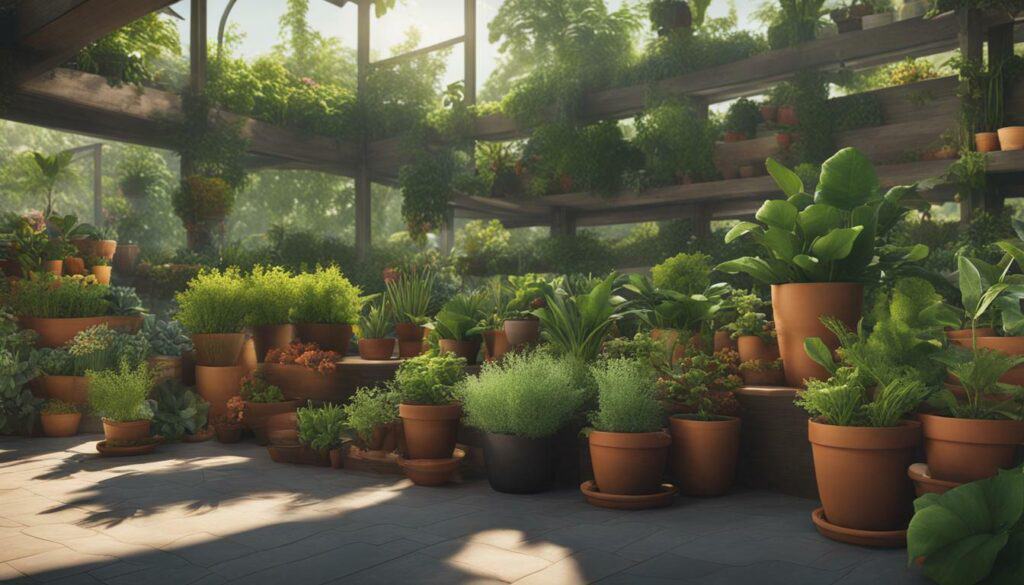
By considering your specific environment and needs, you can select the perfect plant species for your garden design. Taking into account the factors above, such as sunlight and water, as well as proper care techniques, you’ll be on your way to a successful and rewarding plants gardening experience.
Giving Plants the Right Amount of Water
Proper watering is crucial for the well-being of your plants in any plants gardening journey. Understanding the watering needs of different plants is important to avoid overwatering or underwatering, which can lead to root rot or drying out.
When selecting plants for your garden, it’s essential to consider their water requirements and your care style. If you tend to forget to water your plants, drought-tolerant plants like cacti and succulents may be a good fit for you. On the other hand, if you enjoy watering more often, moisture-loving plants such as ferns and peace lilies may be more suitable.
It is also important to choose pots with drainage holes to ensure proper water drainage. When watering your plants, it is best to do so in a sink or outside until the moisture starts to drip out of the pot. This helps prevent overwatering and ensures that the roots receive sufficient oxygen.
Monitoring the soil moisture level is crucial in determining the right amount of water to give your plants. Stick your finger into the soil about an inch deep, and if it feels dry, it’s time to water. If it’s still wet, wait a few more days before watering.
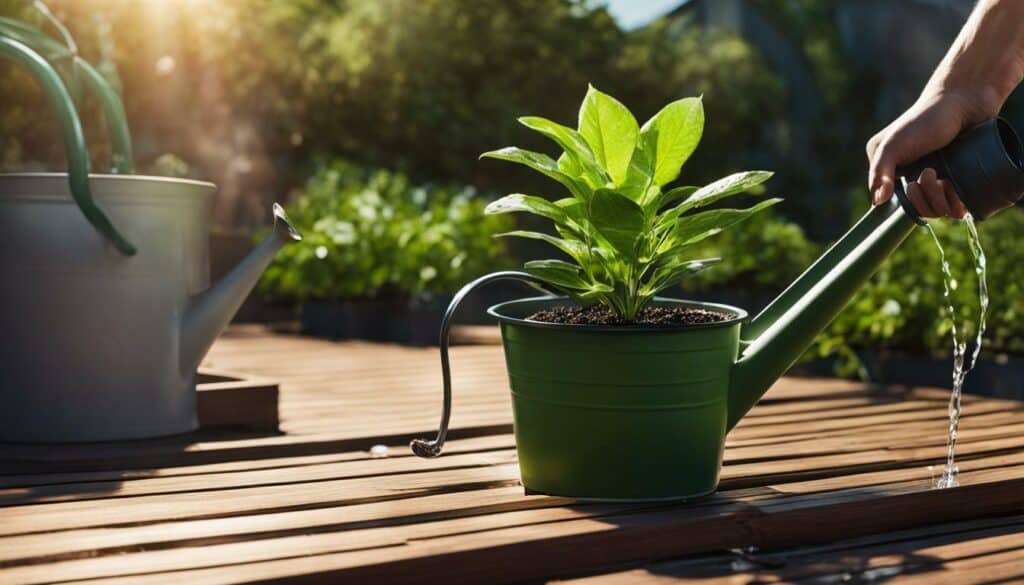
Remember, different plants have different watering needs, so it’s essential to research the specific needs of your plants to maintain their health and vitality. Providing your plants with the right amount of water and sunlight is key to their growth and overall well-being.
Providing the Right Amount of Sunlight
Sunlight plays a vital role in the growth and development of plants in both indoor and outdoor gardens. When selecting plants for your garden, it is important to consider their sunlight requirements. Some plants require direct sunlight, while others prefer indirect or low-light conditions.
For indoor plants, consider the direction and intensity of the sunlight that enters your home. Plants that require direct sunlight should be placed near south- or west-facing windows, where they can receive the most light. On the other hand, plants that prefer low-light conditions, such as ferns or peace lilies, can thrive in north- or east-facing windows or in darker corners of your home.
It is important to monitor your plants for signs of too much or too little sunlight. If a plant is receiving too much sunlight, its leaves may turn yellow or brown and become scorched. If it is not receiving enough sunlight, the leaves may droop or become pale. Rotating your plants occasionally can help them receive more even exposure to sunlight.
When caring for outdoor plants, consider the climate and temperature of your region. Plants that can tolerate high temperatures and direct sunlight are suitable for regions with long, hot summers. On the other hand, plants that can survive colder winters and may require more water are suitable for cooler climates.
Regardless of whether your plants are indoors or outdoors, it is important to provide them with the right amount of sunlight to ensure their health and growth. By monitoring their sunlight requirements and making adjustments as needed, you can help your plants thrive.
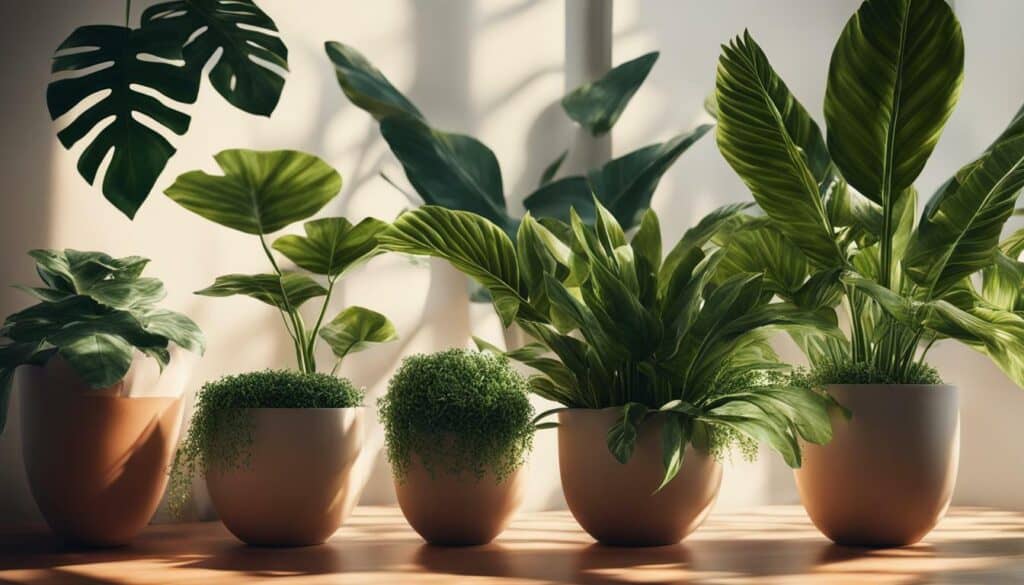
Image alt text: Indoor plants
Fertilizing Plants at the Right Time
Fertilizing your plants at the right time is essential to provide them with the necessary nutrients for healthy growth. Organic gardening techniques can help you grow plants that are free of harmful chemicals. When it comes to fertilizing, it’s important to choose organic fertilizer and use it during the growing season.
The frequency of fertilization will depend on the plant species and the soil conditions. Some plants require more frequent fertilization than others, and some soils may require more nutrients than others. It’s important to read the labels on your fertilizer and follow the instructions carefully.
Over-fertilizing can harm your plants and contribute to environmental pollution, so it’s important to use the right amount of fertilizer at the right time. Typically, plants should be fertilized in the spring and summer months, as this is when they’re most actively growing. Fertilizing in the fall can help plants prepare for winter dormancy.
When fertilizing, it’s important to water your plants beforehand, as wet soil helps nutrients to absorb into the root system. Don’t fertilize plants during drought conditions, as the nutrients can burn the roots. And remember, not all plants require the same amount of fertilizer. Some may only need a light application every few weeks, while others may require a heavier dose every month.
Organic fertilizers can be purchased at most garden centers or can be made at home using compost, bone meal, or blood meal. Organic fertilizers not only provide nutrients to your plants, but also help to improve soil fertility and promote healthy soil microorganisms.
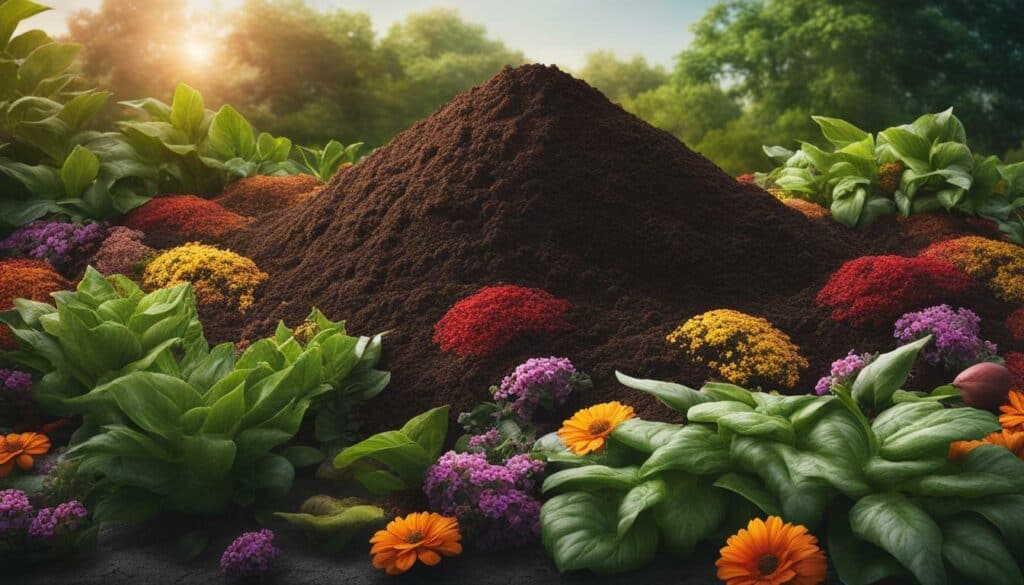
Overall, fertilizing plants at the right time is crucial for their health and growth. By choosing organic fertilizers, following instructions carefully, and considering the needs of individual plants, you can help your plants thrive and grow in a healthy and sustainable way.
Pruning Plants to Keep Them Healthy
Regular pruning is a key practice in plants gardening to maintain the health and vitality of your plants. Pruning helps to remove dead or damaged branches, improve air circulation, and stimulate new growth. It is also essential for shaping plants and preventing diseases.
When pruning your plants, it is important to use the appropriate tools for different sizes of shrubs. For smaller plants, use hand pruners, and for larger ones, use loppers or pruning saws. Make sure your tools are sharp to ensure clean cuts that won’t damage the plant.
Before pruning, identify the branches that need to be removed. Start with any dead or diseased branches and then move on to those that are crossing or rubbing against each other. Cut just outside the collar of the branch, which is the slightly swollen area where the branch meets the trunk.
It’s important to prune at the right time of year. For most plants, late winter or early spring is the best time to prune, before new growth appears. However, some plants, such as hydrangeas, bloom on old wood, so they should be pruned after they bloom in the summer.
When choosing plants for your garden, consider their size and shape at maturity. Prune regularly to maintain the desired shape and size, and to prevent overcrowding. A well-pruned plant not only looks good, but it also promotes healthy growth and reduces the risk of pests and diseases.
By following these pruning tips, beginner gardeners can successfully maintain the health and beauty of their plants. Pruning is just one of the many gardening techniques that can help you grow happy, healthy plants.
Cleaning Plant Leaves Regularly to Prevent Pests
Keeping your plant leaves clean is an essential step in plants gardening to prevent the infestation of pests. Dust, dirt, and debris on the leaves can harbor harmful insects and create a breeding ground for diseases that can damage your plants.
Gently wiping down your plant leaves with a damp cloth or lightly spraying them with water can help remove any buildup and keep your plants healthy. For plants with larger leaves, it may be necessary to use a soft-bristled brush to remove debris.
In addition to regular cleaning, it is also important to inspect your plants for signs of pest infestations. Look for yellowing leaves, webs, or small insects on the leaves or stems. If you notice these signs, take action immediately to prevent the pests from spreading to other plants.
| Plant Species | Common Pests |
|---|---|
| Tomatoes | Aphids, whiteflies, spider mites |
| Roses | Thrips, mites, aphids, caterpillars |
| Peppers | Spider mites, aphids, whiteflies |
Preventing pest infestations is crucial for the health of your plants and the success of your garden. By regularly cleaning your plant leaves and inspecting for signs of pests, you can enjoy a beautiful and thriving garden.
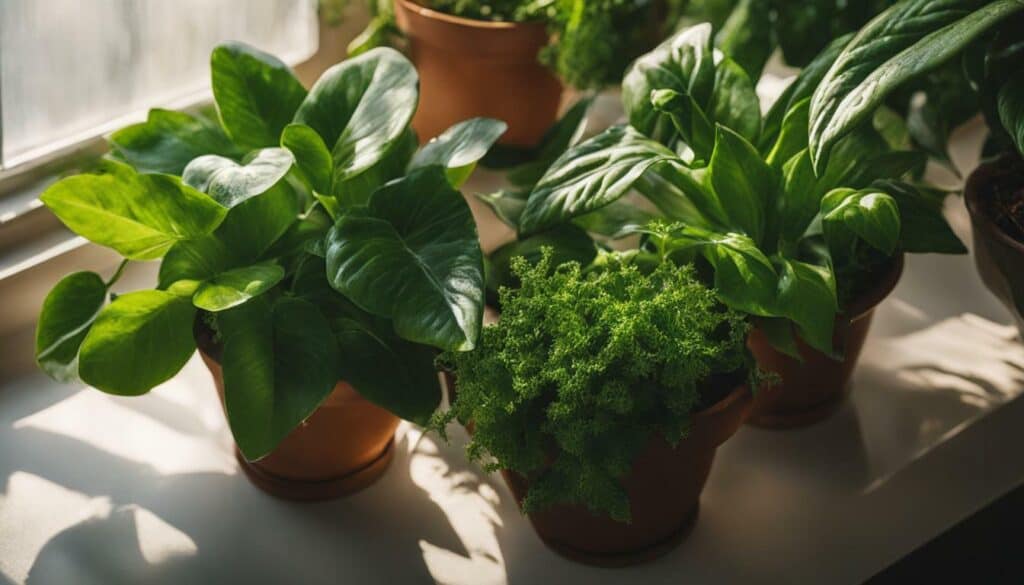
Good Plants for Beginners
If you’re new to plants gardening, starting with certain plant species can help build your confidence and experience. Sansevieria, Succulent/Cactus, Peace Lily, and African Violets are excellent choices for beginners.
| Plant | Sunlight Requirements | Watering Needs |
|---|---|---|
| Sansevieria | Low to bright indirect light | Allow soil to dry between watering |
| Succulent/Cactus | Bright direct light | Infrequent watering, allow soil to dry completely between watering |
| Peace Lily | Low to bright indirect light | Keep soil moist, but not waterlogged |
| African Violets | Bright indirect light | Keep soil consistently moist |
When selecting plants for beginners, it’s important to choose plants that suit the environment they will be living in. Consider factors like sunlight and temperature requirements to ensure the plant thrives in its new home. Additionally, proper watering, sunlight, and pruning are essential for plant care.
Watering should be done until the moisture starts to drip out of the drainage hole in the pot. Be careful not to overwater as this can lead to root rot. Sunlight is crucial for plant growth, but overexposure to sunlight can cause wilting and browning of leaves. Plants should be placed near a window for indirect light.
Pruning, cleaning leaves to prevent pests, and choosing the right plant for one’s environment are also important factors to consider for beginners. Taking the time to properly care for your plants will result in a beautiful and thriving indoor garden.
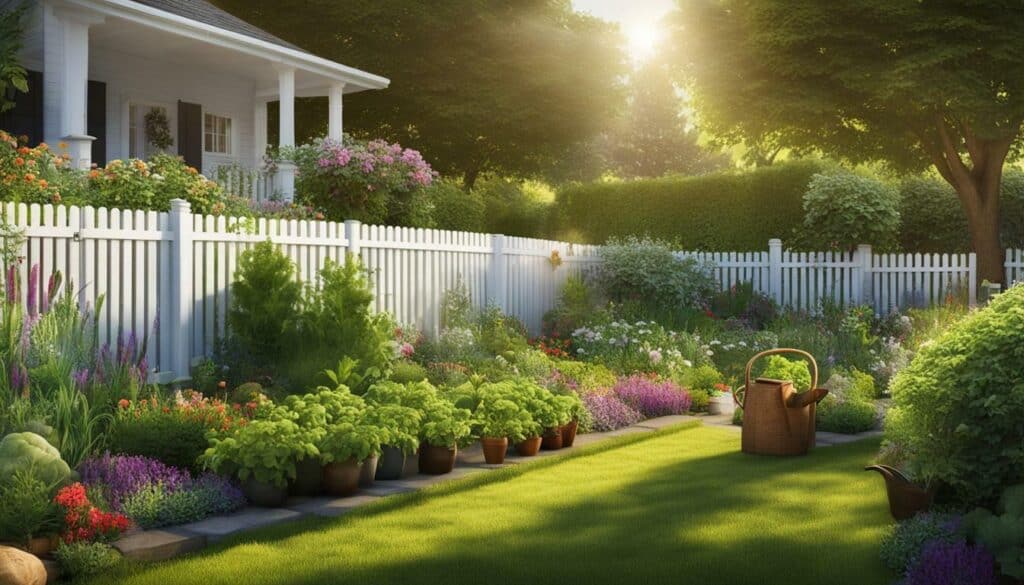
General Tips
Gardening is an enjoyable and rewarding activity that requires time, dedication, and attention to detail. Whether you are a beginner or have years of experience, following these gardening tips can help you achieve success:
- Choose plants that are suitable for your environment. Consider factors such as sunlight, soil type, and climate.
- Provide the proper amount of water and sunlight. Be mindful of each plant’s specific needs and adjust accordingly.
- Prune and fertilize plants as needed. This will promote healthy growth and prevent disease.
- Weed regularly to maintain a clean and organized garden.
- Properly mow, fertilize, water, aerate, and seed your lawn for optimal results.
- For houseplants, provide them with good soil drainage and understand their individual needs.
- Test your soil quality to ensure it is suitable for your plants.
- Utilize appropriate tools and equipment, such as gloves and shovels.
- Join gardening communities to learn from others and share your own experiences.
- Make the most of limited outdoor space by utilizing vertical gardens or container gardening.
By following these general gardening tips, you can enhance and enjoy your gardening experience. Don’t be afraid to experiment and try new techniques – gardening is a continuous learning process!
If you are unsure where to start, consider researching the different gardening techniques and possibilities available. You can also consult with gardening experts or seek advice from experienced gardeners in your community. Remember, gardening is a labor of love and with patience and care, your plants will thrive.

“Gardening adds years to your life and life to your years.”
Conclusion
Gardening is an enriching and fulfilling hobby that allows you to connect with nature and create a beautiful garden space. As a beginner, it is important to choose the right plants for your environment and to consider factors such as sunlight and water requirements. Providing your plants with the right amount of water and sunlight is crucial for their health.
When taking care of houseplants, attention must be paid to watering, soil drainage, and understanding the specific needs of each plant. Lawncare involves activities such as weeding, mowing, fertilizing, watering, aerating, and seeding. Pruning is essential for maintaining the shape and size of shrubs.
When it comes to growing vegetables, beginners can start with lettuce and tomatoes, ensuring they are planted at the right time based on the local climate. Soil quality, proper tools and equipment, and maintaining a well-designed garden layout are key aspects of successful gardening. Pest management should be done using natural methods before resorting to chemicals.
By joining gardening communities and seeking guidance from experts, beginners can learn and grow their gardening skills. The benefits of plants gardening are endless, from improving mental health to providing fresh produce and creating a beautiful outdoor space for relaxation and entertainment.
Join the gardening community!
With these tips in mind, I encourage you to start your plants gardening journey today. Don’t be afraid to get your hands dirty, experiment, and have fun. You’ll be amazed at what you can accomplish and the rewards that come with it!
What Are Some Essential Tips for Planting and Caring for a Home Garden?
When it comes to home garden planting tips, there are a few essential factors to consider. Firstly, understanding your local climate and soil conditions is crucial for selecting the right plants. Secondly, providing adequate water, sunlight, and nutrients will ensure healthy growth. Regular weeding, pruning, and pest control are equally important for caring for your garden. Lastly, maintaining a proper gardening schedule and staying consistent with your efforts will yield fruitful results.
FAQ
Q: How do I choose the right plants for my environment?
A: Consider sunlight and temperature requirements, as well as your plant care style.
Q: How often should I water my plants?
A: Water once a week, checking soil moisture before watering.
Q: Where should I place my houseplants for optimal sunlight?
A: Most houseplants prefer bright indirect sunlight, so place them near a window but not directly in the sun.
Q: When and how should I fertilize my plants?
A: Use a quality planting mix and water regularly, but avoid overwatering.
Q: How should I prune my plants?
A: Light pruning is recommended using appropriate tools like shears or loppers.
Q: How often should I clean my plant leaves?
A: Regularly wipe leaves to prevent pest growth.
Q: What are good plants for beginners?
A: Sansevieria, succulents/cacti, peace lilies, and African violets are good options.
Q: Any general tips for plants gardening?
A: Know your limitations, assess your space and soil quality, and maintain consistent watering and weeding routines.
Q: Where can I find support and knowledge sharing for plants gardening?
A: Join local clubs and online forums dedicated to gardening.
Source Links
- https://plantcareforbeginners.com/articles/houseplants-101-how-to-get-a-green-thumb
- https://www.raise.com/blog/everything-you-need-to-grow-your-green-thumb/
- https://medium.com/@mohammed.touson/gardening-for-beginners-a-comprehensive-guide-to-cultivating-your-green-thumb-8bfd4f73e3a9
- https://extension.illinois.edu/news-releases/give-your-green-thumb-hand-join-vegetable-gardening-workshop
- https://www.naturesupplyco.com/blogs/news/plan-your-way-to-a-green-thumb
- https://www.provenwinners.com/learn/right-plant-right-place
- https://ag.umass.edu/landscape/fact-sheets/right-plant-right-place-plant-selection-guide-for-managed-landscapes
- https://www.realhomes.com/advice/how-to-choose-plants-for-your-garden
- https://www.bobvila.com/articles/watering-plants/
- https://www.realsimple.com/home-organizing/gardening/indoor/watering-plants-rules
- https://www.wikihow.com/Determine-How-Much-Water-Plants-Need
- https://www.bhg.com/gardening/how-to-garden/understanding-your-yard-s-sunlight/
- https://southernlivingplants.com/planting-care/a-gardeners-guide-to-sun-exposure/
- https://extension.psu.edu/planting-in-sun-or-shade
- https://www.lsuagcenter.com/profiles/jmorgan/articles/page1650640626298
- https://www.gardeningknowhow.com/garden-how-to/soil-fertilizers/best-times-to-apply-fertilizer.htm
- https://www.nola.com/entertainment_life/home_garden/when-and-how-often-should-you-apply-plant-fertilizer-tips-timing-more-in-dan-gills/article_b0aa27e7-4bc5-58f7-bc54-665f56398b78.html
- https://www.finegardening.com/project-guides/pruning/maintenance-pruning
- https://housefur.com/pruning-vegetables-what-plants-to-prune-and-which-ones-not-to/
- https://getbusygardening.com/pruning-plants/
- https://www.gardeners.com/how-to/wash-houseplants/5170.html
- https://www.thespruce.com/how-to-clean-houseplant-leaves-1403206
- https://www.bhg.com/gardening/houseplants/care/how-to-clean-your-houseplants/
- https://earthfriendlytips.com/best-plants-for-beginner-gardeners/
- https://www.gardeningetc.com/advice/best-plants-for-beginners
- https://www.lonelypinesfarm.com/top-25-easy-plants-for-beginner-gardeners/
- https://miraclegro.com/en-us/gardening-101/10-top-gardening-tips-for-beginners.html
- https://www.gardenersworld.com/how-to/grow-plants/gardening-for-beginners-10-tips/
- https://www.bhg.com/gardening/yard/garden-care/gardening-tips-for-every-gardener/
- https://msutreehugger.weebly.com/chapter-v-conclusions-and-recommendations.html
- https://growingourown.wordpress.com/6-conclusion/
- https://sites.google.com/a/hanalani.org/growing/conclusion

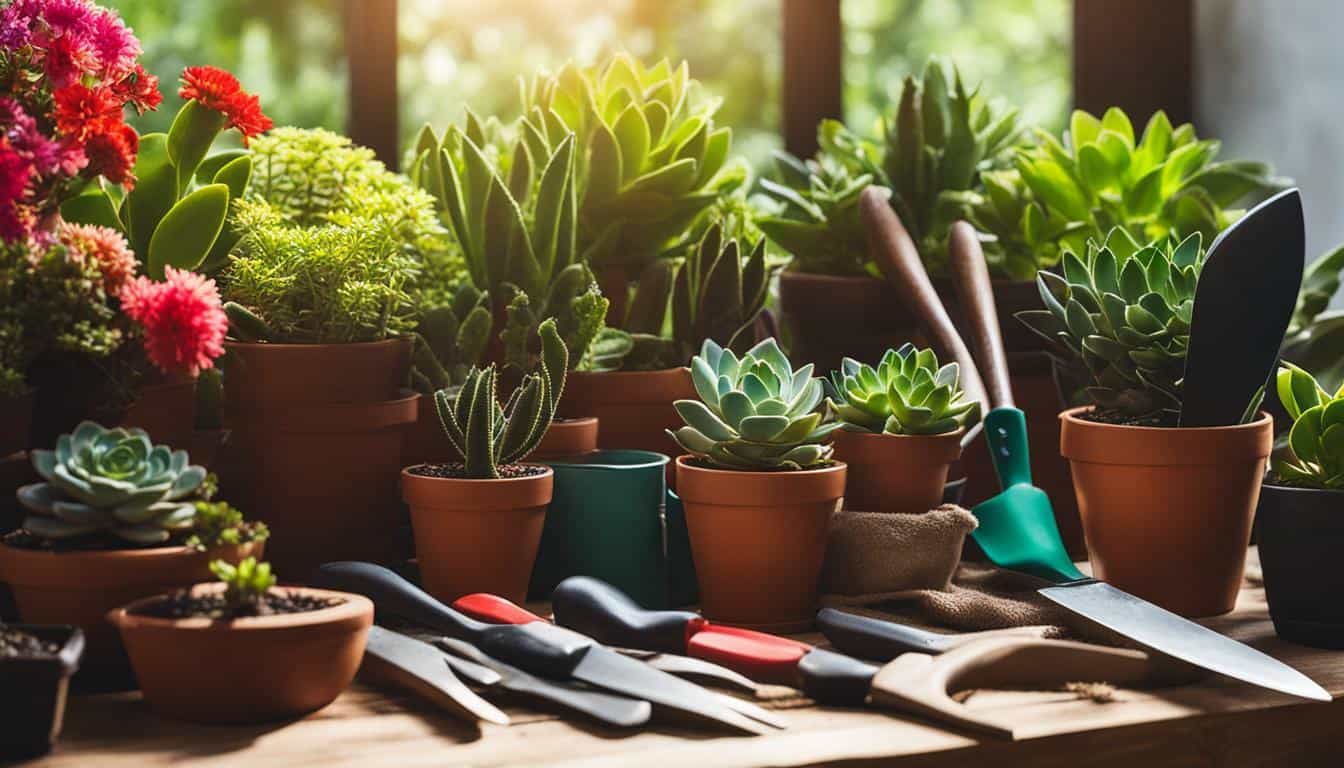



Leave a Reply